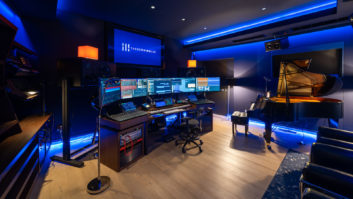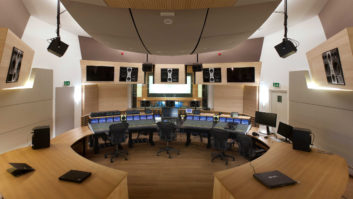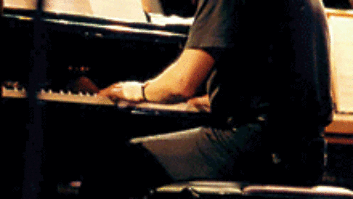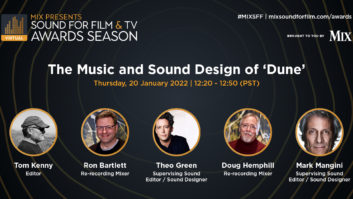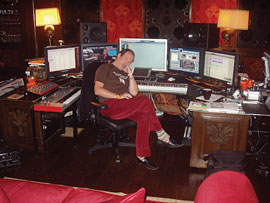
Film composer Hans Zimmer looks up from his computer monitor and keyboard to deal with an interruption. Although he’s busy at work on a score, there is always time for this kind of intrusion: His small children have arrived for a visit and have brought dad some choice artwork to add to his collection.
Hans Zimmer relaxes in his room at Remote Control Productions.
Photos: Matt Hurwitz
Zimmer is master of his domain in the cavernous space known as “Hans’ room” at Remote Control Productions in Santa Monica, Calif. With its exquisite wood paneling and flooring and plush furniture and accoutrements, the room “reminds me of a Viennese brothel,” the composer jokes. While the fine-art books in the bookcases may say one thing about the space, the racks of vintage Moog synthesizer modules and patchbays and rows of other gear send a clearer message: If you come to this brothel, you’d better come equipped with a tune.
Comprising a dozen composing rooms, two state-of-the-art mixing studios and a recording space, Remote Control provides a home not only to Zimmer, but also to a great many other composers who have come up through the ranks to become some of the film and television businesses’ top scorers. Harry Gregson-Williams, John Powell, Steve Jablonsky and James Levine are but a few who take refuge at the facility.
“Harry said to me, ‘Do you know, in the summer, if you look at the box office, four out of the top five films were done by people from here?’” remarks Zimmer, who himself has written scores for such blockbusters as the Pirates of the Caribbean franchise, The Da Vinci Code, The Crimson Tide, The Lion King and so many others.
The facility began 10 years ago when fellow composer Mark Mancina suggested the two share some space. “I wanted to build one room for me, and Mark, who’s a friend, said, ‘Wouldn’t it be nice if we could share space or something?’ It made it cheaper, but, at the same time, it seemed like a nice idea to have a sort of collaborative facility.” Thus was born Media Ventures, which recently changed to its current name, Remote Control Productions.
The collaborative atmosphere concept stuck. Composers routinely pop their heads in to check out colleagues’ work, tossing in the occasional idea. “I probably get more ideas from Heitor [Pereira, composer and Zimmer team member] than I give him,” Zimmer says. “I’ve done 100-odd movies, but every time I start a new one I just sit in front of a blank page.

Al Clay began working with Zimmer in 1983.
“The other day, Harry was mixing something, and after hearing it I just went straight back to my room and threw my stuff away and started again. We are competitive and there is a challenge, on an aesthetic level, which is really great. I heard his piece, and thought, ‘Hang on a second — I better live up to that.’”
ANOTHER SET OF EARS
One collaborator who can frequently be found alongside Zimmer is scoring mixer Al Clay (who alternates with engineer Alan Meyerson, depending on the project and schedules). The two met in London in 1983 at Trident Studios, where Zimmer was busy programming a Fairlight Series I sample sequencer for, as he describes it, “this horrible disco track.”
“I was a tea boy,” Clay recalls. “It was 10 minutes into my first day, while I was being shown my duties. I walked in, sheepishly looking around the room, and saw this guy in leather pants and a flight jacket beating away on something.”
It didn’t take long for Clay to make an impression. “I had just spent three days programming on this little computer,” says Zimmer, “and he came in and tripped over the mains cable — ripped it out of the wall. I hadn’t saved and three days’ work went up in smoke, and I went hysterical.”
“He was screaming, ‘It’s crashed! It’s crashed!’” adds Clay. “I was thinking, ‘Crashed — obviously a bad thing. I don’t know what it means, but I’ll help you fix it.’” Zimmer adds, “He didn’t seem too phased by my screaming, so I thought, ‘Whoa! Character strength. Guy can take a beating.’”
Not long after, Clay was hired by the composer, and the two began working long hours at Zimmer’s tiny studio, Little Yard, in West London. “We used to do tons of commercials, which was a great way for Hans to pay for the new equipment he wanted to use,” Clay says. “We’d literally do two or three jingles in the morning, and then we’d be back on the film score in the afternoon.”
Clay certainly proved his worth on Zimmer’s first big film project, Chris Menges’ 1988 film, A World Apart. “There was one scene that I absolutely didn’t know how to write,” Zimmer recalls. The composer put picture up and simply played against the image. “I hated everything. And then about 9 o’clock, Al said, ‘Well, come and have a listen to this.’ He played me this really beautiful track, and I said, ‘What’s that? Where did you get that from?’ He said, ‘Oh, that’s the first thing you played this morning.’ He knew that I needed to go through the process, and he kept his mouth shut all day. He’d already done it.”
Zimmer brought Clay with him from the UK for his first big American film scoring project that same year, Rain Man, recorded at the former Record Plant West on the Paramount Studios lot.
WRITING TO PICTURES
While the workflow might vary from project to project, depending on the film and its director, Zimmer follows a fairly unique process for his scoring work. Avoiding traditional spotting sessions, Zimmer begins simply by meeting with the director to go over the film. At the same time, he sometimes can base his themes on something as simple as a photograph. While director Gore Verbinski was shooting his 2005 film The Weather Man in Chicago, Zimmer was trying to get a grasp of the film’s emotional experience without seeing any footage. “I said to him, ‘I can’t make heads or tails out of this. What is this going to be? Send me something.’ And he sent me a photograph from the set, with those green hospital walls and with a clock in the corner. And I wrote pretty much the whole thing just from that photo.”
The first thing Zimmer does is create a 20-minute suite containing all of the dramatic and character themes. Once the demo suite is completed, Zimmer will play it for the director and producer. “Hans will explain the parts for each character and the overall feeling,” explains Clay. “It gives the director a chance to say, ‘Yes, I like that,’ or, ‘No, that could be even more…’ But what they hear, actually, isn’t going to change drastically when they walk into the studio and hear the orchestra, so there are no surprises. Hans’ ‘demos’ will be very, very close to the final product.”
Once everyone is in agreement, Zimmer begins composing the film to picture, scene by scene, with director meetings continuing two to three times per week. “Some people work just writing it all out on manuscript and scoring three or four or five days,” says Clay. “The director will come down and hear it for the first time in its finished state with a full orchestra, and they may not like what they hear. Doing it this way just saves you that big surprise at the end.”
Even though he is not composing any of the music himself, Clay is involved in each of those meetings. Says Zimmer. “I don’t see the recording engineer as being separate from the musicians. They can’t do what they do in isolation; we’re all part of the team.”
The team also includes a handful of additional composers who help flesh out Zimmer’s ideas after he’s created his initial composition for each cue. Explains Clay, “Hans will have this great idea, and he’ll pass it on. He’ll rely on these people all around him to see it through.”
“Hans gives you a road map of the cue,” explains composer Henry Jackman. “He’s written a 2:30 piano piece, with loads of key changes, the mood of the movement. So you’ve pretty much got all the ammunition, emotionally.” Jackman will lock the cue exactly to picture and begin applying Zimmer’s music to the scene. “If you don’t do that by the frame and you start doing a massive orchestration, you might find yourself going, ‘Hang on a minute. I’m missing all the cuts.’ It’s much better to apply the map first.” Once completed, he can begin orchestrating the cue, with Zimmer dropping in every so often throughout the day to make sure Jackman’s work maintains his original ideas.
Zimmer’s own composing environment is made up of a mixture of state-of-the-art recording technology and vintage instruments and sources. Choosing which instruments will be used for which film depends on the project, he says. “And people constantly seem to mis-hear what I’m doing. They’re criticizing synth sounds on Pirates when there are no synth sounds. All it is is an orchestra shoved through a big Marshall stack.
The composer has a great affection for analog synth equipment, including Moog modules recently used on The Da Vinci Code. “There just came one bit where I had to drag out the big old Moog because nothing else had that sort of resonance.” He typically records to Pro Tools using a Cubase sequencer and GigaSamplers.
New equipment and software arrive fairly regularly at Remote Control, but it rarely is put to use straight out of the box. Upstairs in a loft space filled with cool old gear (like a Commodore 64 with its original ROM card and built-in MIDI interface), engineer Mark Wherry can be found taking things apart and making them fit. “[Wherry is] really a thinker and philosopher of musical technology,” Zimmer says.
“Mark doesn’t just screw around with stuff,” Clay comments. “He actually has the ability to take the software and rewrite it.”
According to Wherry, “There’s a lot of things that Hans uses, like the touchscreen in front of him that has custom software that drives it. And we’ve customized things to allow the Gigas to work slightly better.” He and his team also designed and built a custom network MIDI solution that can handle the facility’s 14 GigaStudio computers with a large number of MIDI interfaces.
The mixing system includes three Pro Tools rigs — one for synth outputs of Zimmer’s drums and percussion, etc.; one for orchestra; and a third to handle the mix. Clay says Zimmer remains quite involved down to the mixing stage.
“He’ll have a definite plan of what he wants, and he thinks spatially,” notes Clay. “For Da Vinci Code, he had a vision of the viols up in the gallery at AIR Studio, and as he was writing he knew that would be the case. So when it came time for mixing, he knew he wanted them in the surrounds, and we put them up there.
“A lot of people are either techno-heads or they’re strictly composers and fumble with the technology,” Clay says. “One of the great things about Hans is that he’s got that technical head, but also the free composer head, and he somehow manages to marry the two.”
